Getting through TSA and airport security is already stressful enough but there’s an additional screening method that you might be subjected to at times.
And it happens when you find those dreaded four letters, “SSSS” on your boarding pass.
Some people absolutely dread this additional screening but is it really that bad?
In this article, I’m going to show you what it means to have SSSS on your boarding pass and what you can expect during the screening process.
I’ll also give you some tips for how to avoid getting SSSS in the future!
Table of Contents
What does “SSSS” mean on a boarding pass?
If you see the letters “SSSS” on a boarding pass it means that you’ve been selected for “Secondary Security Screening Selection” and that you may be subjected to additional screening measures, such as invasive pat-downs, swabs for explosives, and tedious luggage inspections.
While this sounds bad and can be quite time consuming, based on my personal experience, the process isn’t always as painful as some make it out to be. It’s possible that this advanced search could only take a few extra minutes to get through but there are instances where it could take much longer than that (30 plus minutes).
Many times travelers will receive SSSS randomly but there are some situations that could trigger SSSS, such as irregular travel patterns, travel to high-risk countries, paying cash for your ticket, and when your name is on a watchlist.
If you constantly receive SSSS and you don’t believe its random, you can apply for a redress number which might remedy your situation, though there are no guarantees.
Note: Having Global Entry/TSA Pre-Check will not prevent you from getting hit with SSSS.
Keep reading below to find out more details including how my multiple experiences with SSSS have gone.
Tip: Use the free app WalletFlo to help you travel the world for free by finding the best travel credit cards and promotions!
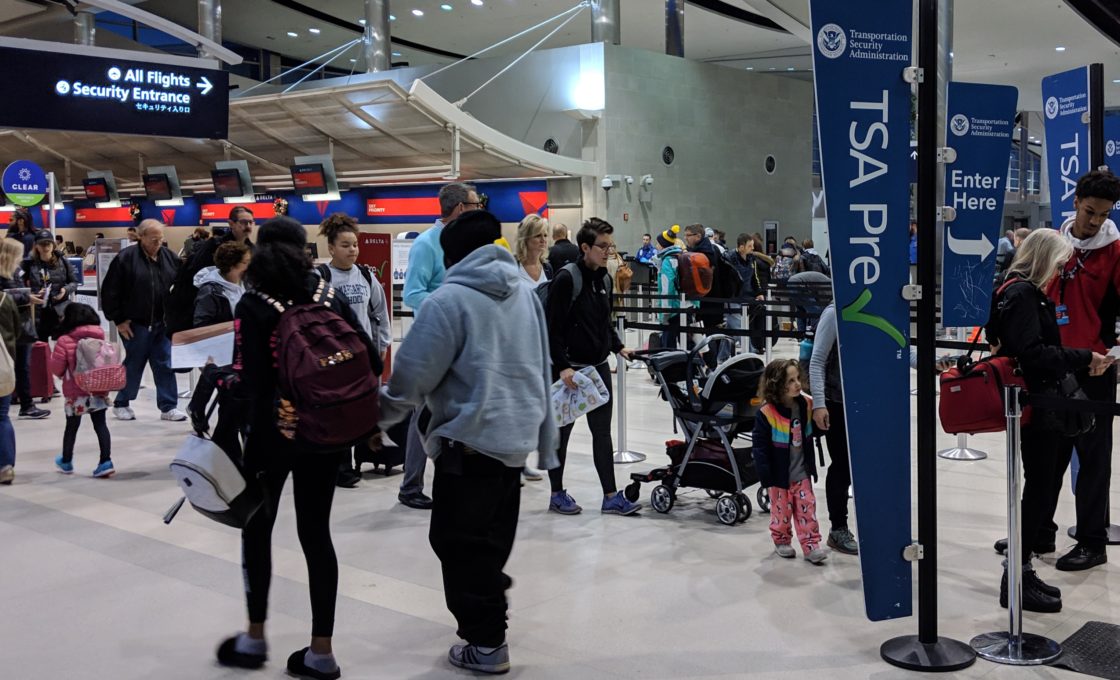
How do I know if I have an SSSS boarding pass?
As you get closer to the time of your planned departure, you may start getting signs that you might be subject to SSSS. Here’s what to look out for.
When you can suspect SSSS
The first sign that you might be getting hit with SSSS (also known as the “quad”) is if you go to check-in for your flight on your phone or online and you’re unable to pull up a boarding pass.
Instead of receiving confirmation of your check-in, you might just see a message that says something like “you need to inquire with the check-in desk” or you might even see an error screen.
Sometimes, this can just be a system quirk you have to resolve at the airport but if you’re going to be subject to SSSS, there’s a high chance you won’t be able to pull up your boarding pass online prior to arrival.
On my very first long-haul international flight (to Australia) I was selected for SSSS.
The first sign?
I wasn’t able to print out a ticket from the check-in kiosk and it actually took United a long time to get the computers to finally issue me a boarding pass.
And then when I arrived at the gate, I had to head over to a screening area where I was patted down and my luggage was opened up and searched.
So if this happens to you, I suggest that you plan on arriving extra early to the airport just in case you have to go through enhanced screening.
When you know for sure
The way you know for sure you’ve been selected for SSSS is that you’ll see “SSSS” printed on your boarding pass, usually near the corner or edges and in bolded letters that are hard to miss.
Check the image below for what it might look like.
Sometimes the agent who printed your ticket will inform you of your misfortune but other times they’ll simply allow you to find out on your own.
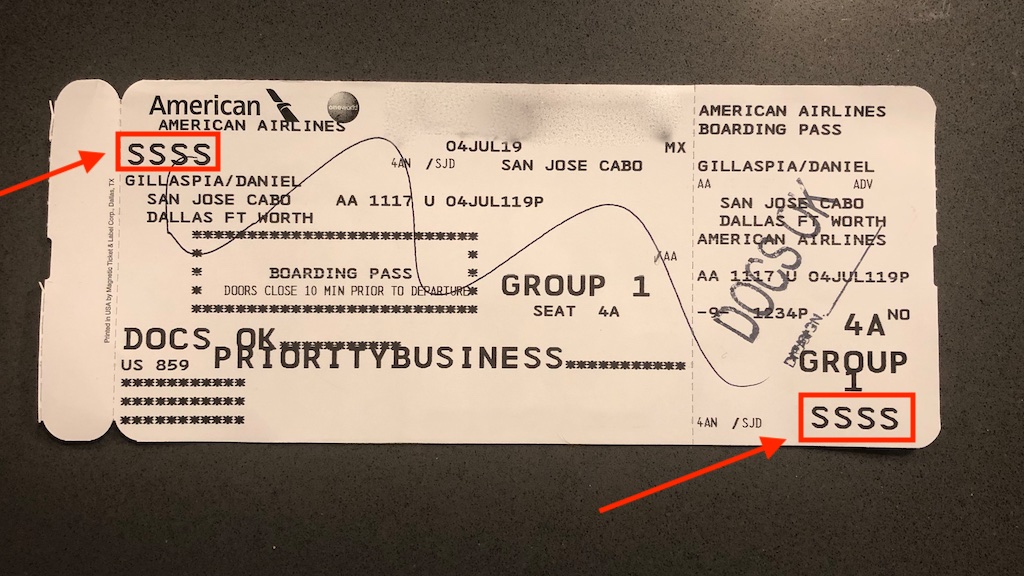
Who gets SSSS on their boarding pass?
There are different reasons why you might get SSSS on your boarding pass but TSA does not share many specifics.
Why not?
They need security to remain somewhat unpredictable in order to avoid bad actors learning how to get around screening mechanisms.
But based on my own personal experiences and the many experiences of other travelers, we do have some idea of who gets selected for SSSS.
Name is on a Terrorist Screening Database (TSDB) list
When you purchase an airline ticket, your full name and personal details like your gender and date of birth will be sent to TSA to be cleared by TSA’s Secure Flight program.
Their goal is to “identify known or suspected terrorists or other individuals who may be a threat to transportation or national security.”
The TSA uses data from the FBI’s Terrorist Screening Database (TSDB) to create different screening lists including the:
- No Fly List
- Selectee List
- Expanded Selectee List
Someone on the no-fly list won’t have to worry about SSSS because they are “not allowed to board a commercial aircraft flying into, out of, over, or within United States airspace.”
But someone on one of the other lists may just be subjected to SSSS.
The problem is that even if your name resembles a name on that list it could also trigger SSSS (more on how to remove that later).
Visits to high-risk countries
The government may have deemed you an at-risk traveler based on your recent visits to countries deemed “high-risk” by the State Department.
This could be countries in certain regions of the world like the Middle East or Africa. For example, Turkey appears to be one of the problematic countries for a lot of people.
After you visit one of these countries, you might get hit with SSSS multiple times following your journey. It might eventually go away but if it doesn’t you might have to seek a redress number.
Unusual travel patterns
Another trigger could be abnormal travel patterns.
Maybe you have a very quick turnaround at a destination, such as flying across the world for a few hours or one night and then coming back.
Or perhaps you decide to jump on the last minute travel deal — you could look like someone trying to flee the country for some reason and that could trigger SSSS.
Another instance could be taking a one-way trip to somewhere, especially to a high risk country.
Passengers who pay cash for their tickets
It’s no secret that many criminals love to use cash in order to get around without leaving a trace. This is especially true when traveling in hotels, taxis, planes, etc.
For that reason, paying cash for your ticket could land you with the quad.
Passengers who appear suspicious
If you appear suspicious when making your way through the airport it’s possible that you could get one of these screenings.
Some report that airline staff members at the ticketing desk have the power to select you for SSSS.
Random selection
It’s speculated that there is a random component to SSSS. For example, a certain percentage of passengers may always be selected for the screening.
The take-a-way is that anything that could remotely resemble sketchy activity could increase your odds of getting secondary screening.
Some people even state that doing things like re-printing an international boarding pass could trigger SSSS, so I always try to avoid re-printing international tickets.
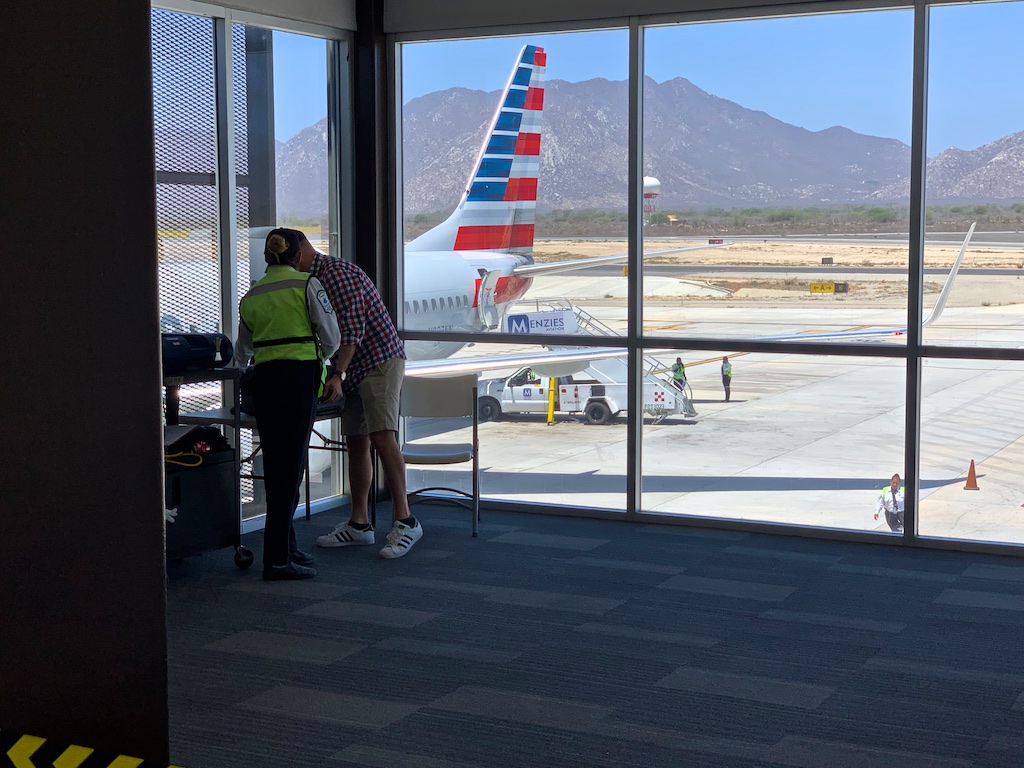
What is an SSSS search like?
The SSSS experience can begin as early as entering the security line.
If you have TSA Pre-Check, it’s likely that you won’t get Pre-Check on your boarding pass and will have to go through the standard security line or a line dedicated for airline elites (if that fits you).
Tip: Some have reported having success “cutting” the long security line by showing a TSA agent that you’ve got to go through an SSSS check.
Once you show your boarding pass and ID, a TSA agent will likely call for someone (or even a small team of TSA agents) to initiate your search.
Sometimes there is nobody currently available and you might have to wait several minutes for your search (especially if they are trying to find someone of the same gender), so if you’re cutting things close this can actually be a big problem.
The search experience can vary but generally you can expect a few things.
First, you might be subjected to multiple scanners/x-rays and even asked to go through them more than once. (The search may be similar to what you would get if you forgot your ID.)
Second, they’ll ask you to unpack many of your belongings, especially electronics.
Your belongings, clothing, and hands, may be swabbed all over, multiple times even.
Sometimes the agents will ask you to power on your electronics (if you can’t power it on that can become a big issue so keep things charged up!).
Tip: If you’re traveling with a partner, it’s a good idea for the SSSS passenger to take the bag with fewer items/electronics to make thing easier. We have one designated carry-on filled with electronics and hand that off if needed.
You also will likely get a pat down which can be very in-depth and hands will likely come close to places you’d rather them not to be.
If you prefer, you can get this “enhanced” pat down in a private screening area.
Other times the SSSS screening will take place near the gate like when I left for Australia from LAX.
If you’ve already been searched, your boarding pass should have been stamped and they should see that at the gate, allowing you to avoid a second additional screening but some have reported 2X the screening.
Brad recently got “hit with the quad” when we departed Milan to JFK on Emirates first class.
The SSSS search actually took place in a closed off area in the first class and business class lounge. Those SSSS passengers got to board first so it wasn’t a bad deal but that’s not always how it works.
I recently got SSSS again when departing Los Cabos, Mexico, for Dallas, Texas.
The screening process was very simple, though.
I didn’t get a pat down and was not forced to unpack my baggage. Instead, they only swabbed the exterior of my bags and then checked the inside of my shoes.
The process only took about one to two minutes and then it was adios.
The worst part of it was the looks I got from some of the other passengers who seemed to assume that I’d been caught smuggling drugs from Baja California.
Tip: Use WalletFlo for all your credit card needs. It’s free and will help you optimize your rewards and savings!

How long does the SSSS search take?
Overall, the time for the SSSS search can range drastically from a couple of minutes to 30+ minutes so try to be as patient as possible.
Oftentimes, these diligent agents are aware that their procedures may cause inconvenience, and they strive to ensure a seamless and hassle-free experience for you. However, it’s worth noting that there may be instances where this isn’t always the case.
How does SSSS affect connections?
If you have connecting flights, it’s possible that you will have to go through SSSS multiple times, especially if those connections are in the US.
But many times you won’t get SSSS on your connecting flights.
When I received SSSS for my flight from Cabo to DFW, I did not have SSSS on my boarding pass from DFW to IAH when connecting.
If your connection is from abroad and you’re coming to the US, you might not have to go through SSSS at your original point of departure.
So I advise to always review all of your boarding passes when they are issued at check-in so that you’ll know what to expect.
Does Global Entry or TSA Pre-Check prevent SSSS?
Unfortunately, Global Entry does not prevent you from receiving SSSS on your passport.
Plenty of people, including myself and Brad, have gotten SSSS even after joining Global Entry/TSA Pre-Check.
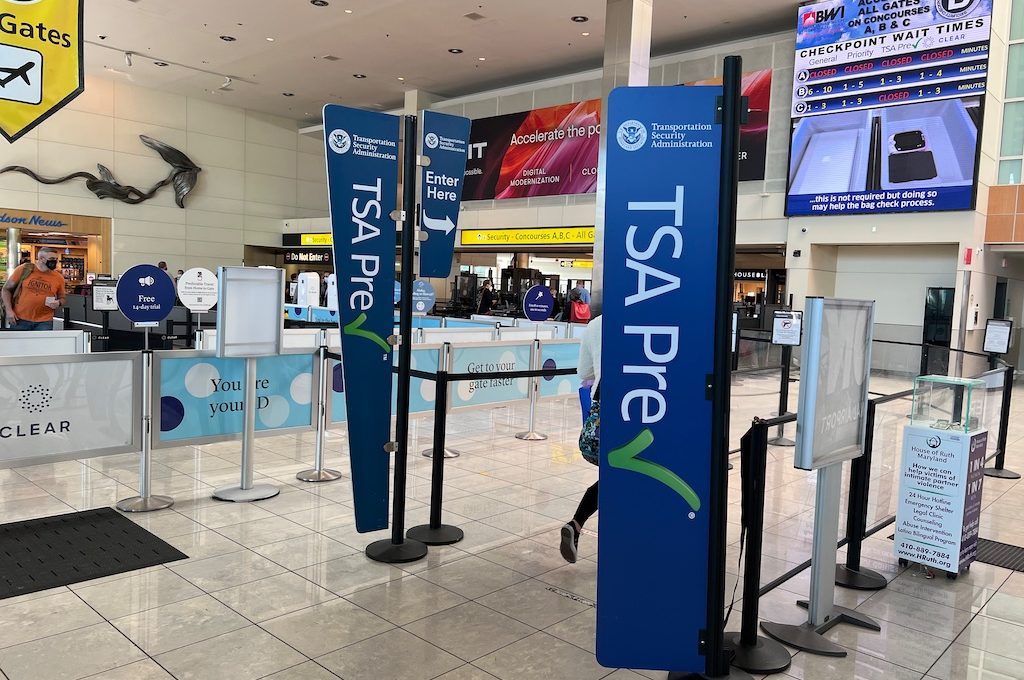
How can I prevent an SSSS search?
There’s no for sure way to 100% prevent being issued a boarding pass with SSSS.
Some have reported that you can ask an airline agent at the check-in desk to re-issue a boarding pass without SSSS but it’s not clear to me what the success rate is when doing so and how much control the airlines have in the process.
However, if you’ve been subject to SSSS on a repeated basis, you can apply for a redress number.
The Department of Homeland Security set up the redress program (called DHS TRIP) to remedy these situations and here’s what the DHS states about it:
Traveler Redress Inquiry Program (DHS TRIP) is a single point of contact for individuals who have inquiries or seek resolution regarding difficulties they experienced during their travel screening at transportation hubs—like airports and train stations—or crossing U.S. borders
The redress number will be a special case number that the DHS issues to help you avoid unnecessary additional screening.
Basically, it’s a way for the government to give you a second look to make sure that you’re not a high-risk traveler.
Sometimes your name may have ended up on a list because it’s the same or similar to someone who is on a no-fly list and a redress number can fix that.
To get a redress number you simply need to go through the application process which you can do online.
It doesn’t take very long at all to fill out and you just need to mail in a signed form along with a copy of your passport or other qualifying document.
Sometimes you can hear back within a week but other times it could take a couple of months.
Unfortunately, this method is not full proof for everyone and so there is no guarantee it will always work.
Is the SSSS program effective?
A lot of people question whether or not the program is effective in deterring terrorists.
The biggest concern is that one would see “SSSS” plainly on their boarding pass and then simply decide to abandon their plans.
Well, even if that is the case, the SSSS still acts as a deterrent so I guess I would consider that a success to a degree.
But if you know anything about TSA you have have heard about the 95% failure rate with detections so I think it’s fair to say that there may be much bigger issues to address related to airport security like the effectiveness of the standard screening procedures.
Final word
Overall, getting SSSS on your boarding pass is not the worst thing that can happen to you.
It can be an inconvenience because you have to set aside time for the search and endure pat downs but I don’t think it’s anything to dread in a lot of cases.
And if it becomes a repeated problem, you can look into getting a redress number so that you can try to avoid getting SSSS in the future.
Daniel Gillaspia is the Founder of UponArriving.com and the credit card app, WalletFlo. He is a former attorney turned travel expert covering destinations along with TSA, airline, and hotel policies. Since 2014, his content has been featured in publications such as National Geographic, Smithsonian Magazine, and CNBC. Read my bio.

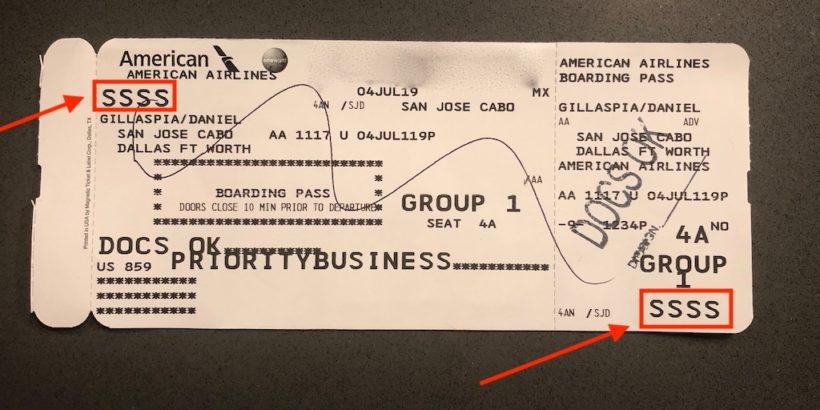
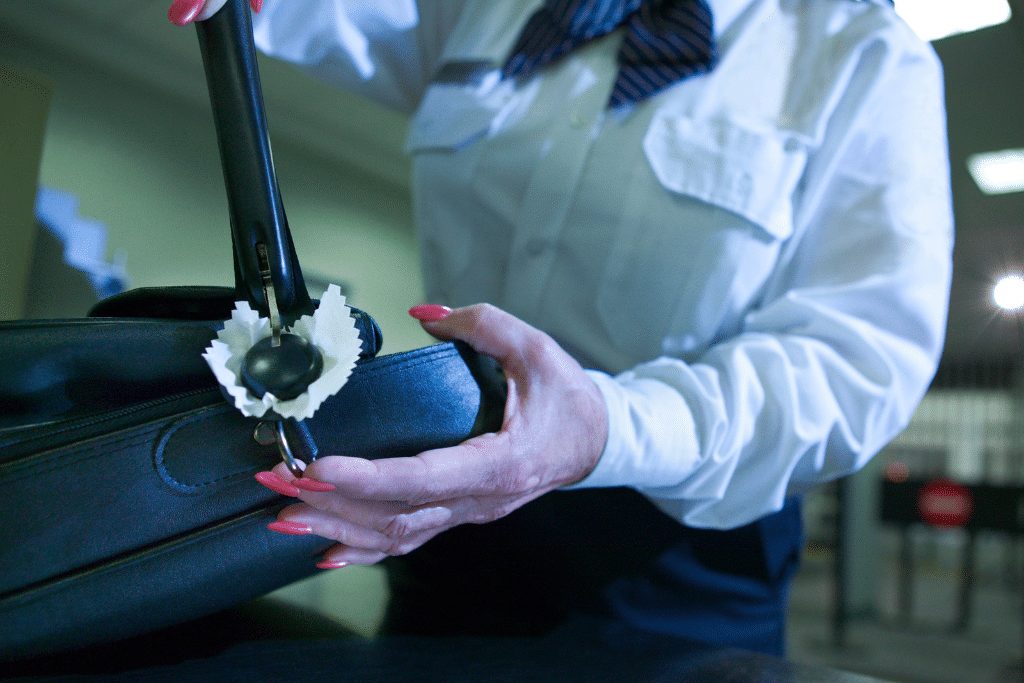
On the last three Westjet flights I have been subject to the SSSS stamp on my boarding pass and have had the inconvenience of special security treatment . How do I apply for that redress application
thanks for the article. Yesterday i was pulled over by them pigs, probbly because i came to Miami directly from Istanbul, and before that – Russia. Most likely, even though i am a permanent reident, this – is my last trip to this god forsaken place. They searched me for like 4 hours, asked millions of stupid questions, and finally took my iphone for “additional” screening. Madafakas were talkin about “child pornography”, which i told them they can be my guests if they find any, bitches…
so now, i am left without my phone for no frickin reason, hate them broads, and they better return my phone within them 5 days
I entered the capital on J6 carrying a sign, then left. I found myself on the list, as I was eventually charged with a misdemeanor. A misdemeanor, and now I’m a suspected terrorist. BTW…my wife and family are also on the list, and they did nothing! Our current illegitimate govt is pure evil – total police state. SSSS is a political weapon. Has NOTHING to do with security. Oh, and the additional time….allow 2-3 hours extra, as the airlines take an hour to figure out what this even is. Horrific what has happened to our country. While this article is informational, the writer appears to think this is “no big deal”. He’s clueless in that regard.